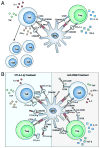Costimulation Blockade in Autoimmunity and Transplantation: The CD28 Pathway
- PMID: 27591335
- PMCID: PMC5370073
- DOI: 10.4049/jimmunol.1601135
Costimulation Blockade in Autoimmunity and Transplantation: The CD28 Pathway
Abstract
T cell activation is a complex process that requires multiple cell signaling pathways, including a primary recognition signal and additional costimulatory signals. TCR signaling in the absence of costimulatory signals can lead to an abortive attempt at activation and subsequent anergy. One of the best-characterized costimulatory pathways includes the Ig superfamily members CD28 and CTLA-4 and their ligands CD80 and CD86. The development of the fusion protein CTLA-4-Ig as an experimental and subsequent therapeutic tool is one of the major success stories in modern immunology. Abatacept and belatacept are clinically approved agents for the treatment of rheumatoid arthritis and renal transplantation, respectively. Future interventions may include selective CD28 blockade to block the costimulatory potential of CD28 while exploiting the coinhibitory effects of CTLA-4.
Copyright © 2016 by The American Association of Immunologists, Inc.
Figures

References
-
- Hedrick SM, Cohen DI, Nielsen EA, Davis MM. Isolation of cDNA clones encoding T cell-specific membrane-associated proteins. Nature. 1984;308:149–153. - PubMed
-
- Lafferty KJ, Woolnough J. The origin and mechanism of the allograft reaction. Immunol Rev. 1977;35:231–262. - PubMed
-
- June CH, Ledbetter JA, Linsley PS, Thompson CB. Role of the CD28 receptor in T-cell activation. Immunol Today. 1990;11:211–216. - PubMed
Publication types
MeSH terms
Substances
Grants and funding
LinkOut - more resources
Full Text Sources
Other Literature Sources

